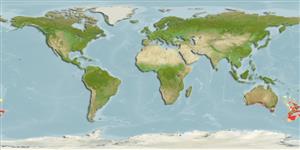Common names from other countries
Environment: milieu / climate zone / depth range / distribution range
Οικολογία
Θαλασσινό(ά) βαθυπελαγικό(ς); μη μεταναστευτικό(ά); εύρος βάθους 180 - 1000 m, usually 270 - 450 m (Ref. 9563). Deep-water; 21°S - 56°S, 113°E - 172°W
Eastern Indian Ocean and Southwest Pacific: Australia ( Western Australia, South Australia, Victoria, New South Wales and Tasmania) and New Zealand.
Μέγεθος / Βάρος / Age
Maturity: Lm ? range ? - ? cm
Max length : 51.3 cm TL αρσενικό/απροσδιόριστο; (Ref. 128324); 60.7 cm TL (female)
Ραχιαίες άκανθες (συνολικά) : 0; Εδρικές άκανθες: 0. Head with scarcely developed ridges; eyes large; chin barbel short; light organ small, adjacent to anus. First dorsal-fin spine smooth. Scales densely covered with lanceolate spinules, arranged in quincunx or convergent rows.
Occurs on the continental slope (Ref. 9563).
Life cycle and mating behavior
Maturities | Αναπαραγωγή | Spawnings | Egg(s) | Fecundities | Προνύμφες
Cohen, D.M., T. Inada, T. Iwamoto and N. Scialabba, 1990. FAO species catalogue. Vol. 10. Gadiform fishes of the world (Order Gadiformes). An annotated and illustrated catalogue of cods, hakes, grenadiers and other gadiform fishes known to date. FAO Fish. Synop. 125(10). Rome: FAO. 442 p. (Ref. 1371)
IUCN Red List Status (Ref. 130435)
CITES (Ref. 128078)
Not Evaluated
Threat to humans
Harmless
Human uses
αλιεία: περιορισμένης εμπορικότητας
Εργαλεία
Special reports
Download XML
Διαδικτυακές πηγές
Estimates based on models
Preferred temperature (Ref.
115969): 6.9 - 12.5, mean 9.2 (based on 58 cells).
Phylogenetic diversity index (Ref.
82804): PD
50 = 1.0000 [Uniqueness, from 0.5 = low to 2.0 = high].
Bayesian length-weight: a=0.00129 (0.00082 - 0.00202), b=3.14 (3.01 - 3.27), in cm Total Length, based on LWR estimates for this species & (Sub)family-body (Ref.
93245).
Τροφικό Επίπεδο (Ref.
69278): 3.7 ±0.53 se; based on food items.
Ελαστικότητα (Ref.
120179): Χαμηλό, ελάχιστος χρόνος για διπλασιασμό πληθυσμού 4,5 - 14 έτη (Assuming tm>4).
Fishing Vulnerability (Ref.
59153): Moderate vulnerability (44 of 100).
Climate Vulnerability (Ref.
125649): Moderate to high vulnerability (50 of 100).
